Why Philippines’ property market is a gem hidden to most investors
South China Morning Post
17 June 2024
Investors overlook the Philippines, but Southeast Asia’s fastest-growing economy is attractive, affordable and has more potential to unlock
A cursory glance at Asian commercial real estate transaction volumes shows which countries dominate the investment landscape. In the past decade, Japan, China, Australia and South Korea have accounted for the lion’s share of direct investment. Within Southeast Asia, Singapore is the sole heavyweight, making up at least 80 per cent of investment activity.
It is therefore not surprising that the Philippines gets little attention. Lacking the economic heft of Indonesia, the manufacturing prowess of Vietnam and the tourist appeal of Thailand, the Philippines often takes a back seat to its regional peers. However, it is at the forefront of important trends in the real estate industry, some of which are underappreciated and overlooked.
At a time when global house prices are rebounding, the luxury market in Manila is going gangbusters. According to a Knight Frank index of prime residential prices in 100 cities across the world, the Philippine capital recorded the fastest growth last year. Prices grew a staggering 26.3 per cent, even outpacing Dubai. Manila also held the top spot in the first quarter of this year.
The combination of strong demand stemming from the sharp rise in the number of high-net-worth individuals and tight supply has driven up prices. The Philippines was Southeast Asia’s fastest-growing economy last year and has enjoyed annual growth rates in the past decade that have been almost on a par with India’s.
However, capital values are much lower than in the leading cities in Asia. According to Knight Frank, US$1 million bought 158 square metres (1,700 square feet) of prime residential property in Manila in 2022, compared with just 34 sq m in Singapore, 60 in Tokyo and 113 in Mumbai. The Philippine capital’s luxury market is booming but remains relatively affordable.
In the retail industry, bricks-and-mortar shopping is thriving. At a time when physical retail faces acute challenges mainly because of the disruption caused by the rise in online purchases, the Philippines is a shopping centre landlord’s paradise. With private consumption accounting for more than 75 per cent of economic output and the online share of retail spending standing at just 2 per cent in 2022, Manila’s shopping centres are in an enviable position.
It might come as a surprise that Manila is home to two of the world’s largest shopping centres. In a country with heavy rain and high temperatures and humidity, big shopping centres are as much a refuge as they are an entertainment destination. “Malling is a way of life here, providing shelter from the rain and heat,” said Joe Curran, chief executive at KMC Savills in Manila.
Yet it is the expansion of the business process outsourcing (BPO) industry that is the big story in Philippine commercial real estate. Not only is the sector the country’s largest employer, it is a key driver of growth and the main source of leasing demand in the office sector. Revenues have been increasing at an annual rate of 9 per cent since 2019 and are expected to reach a hefty US$38 billion this year.
The Philippines supplanted India as the world’s call centre hub more than a decade ago. A former US colony with a large population of young people, many of whom speak English, the Philippines is fertile ground for multinational firms seeking to streamline their operations and optimise their back-office functions. A popular way to do this is to take advantage of lower labour costs and deep talent pools in emerging markets.
Filipino agents attend to foreign clients at an Advance Contact Solutions call centre facility in Quezon City, in suburban Manila. Photo: AFP
According to data from Knight Frank, offshoring-related wage costs in the Philippines are still significantly lower than in India while prime office rents in Manila are almost 50 per cent lower than in Bengaluru, Mumbai and New Delhi.
This provides an incentive for multinational companies to place more call centres in the Philippines. “For every 100 jobs they outsource to India, they add 10 to 20 in the Philippines,” said Anshul Jain, head of Asian tenant representation and managing director for India and Southeast Asia at Cushman & Wakefield.
In the first quarter of this year, outsourcing and offshoring accounted for 53 per cent of leasing activity in metropolitan Manila’s office market. In Cebu, the share was as high as 80 per cent, according to JLL.
Not surprisingly, there are concerns the Philippines is more vulnerable to the rise of generative artificial intelligence (AI) than others. A large share of BPO jobs in the country are low-skilled ones, yet AI could serve as a catalyst for upskilling and higher-value services. “The industry saw this coming and knows it has to move up the value chain,” said Morgan McGilvray, senior director, occupier strategy and solutions, at Knight Frank in Manila.
The bigger threat to the office market is remote working, which has become more prevalent since the Covid-19 pandemic. Long commutes from suburban areas to central Manila, exacerbated by decades of underinvestment in infrastructure, have increased the appeal of hybrid work and spurred the decentralization of the office market.
Poor infrastructure has also stymied the development of the Philippine tourism industry. In 2019, Thailand welcomed nearly 40 million international tourists, nearly five times as many as the Philippines. For a country with stunningly beautiful beaches and coral reefs, this is lamentable.
The good news is the government is investing in infrastructure. Airports are being built and modernised, which could help unlock the country’s tourism potential. The Philippines is rarely on investors’ radar, but there is more to its property market than meets the eye.
Nicholas Spiro is a partner at Lauressa Advisory



No comments:
Post a Comment